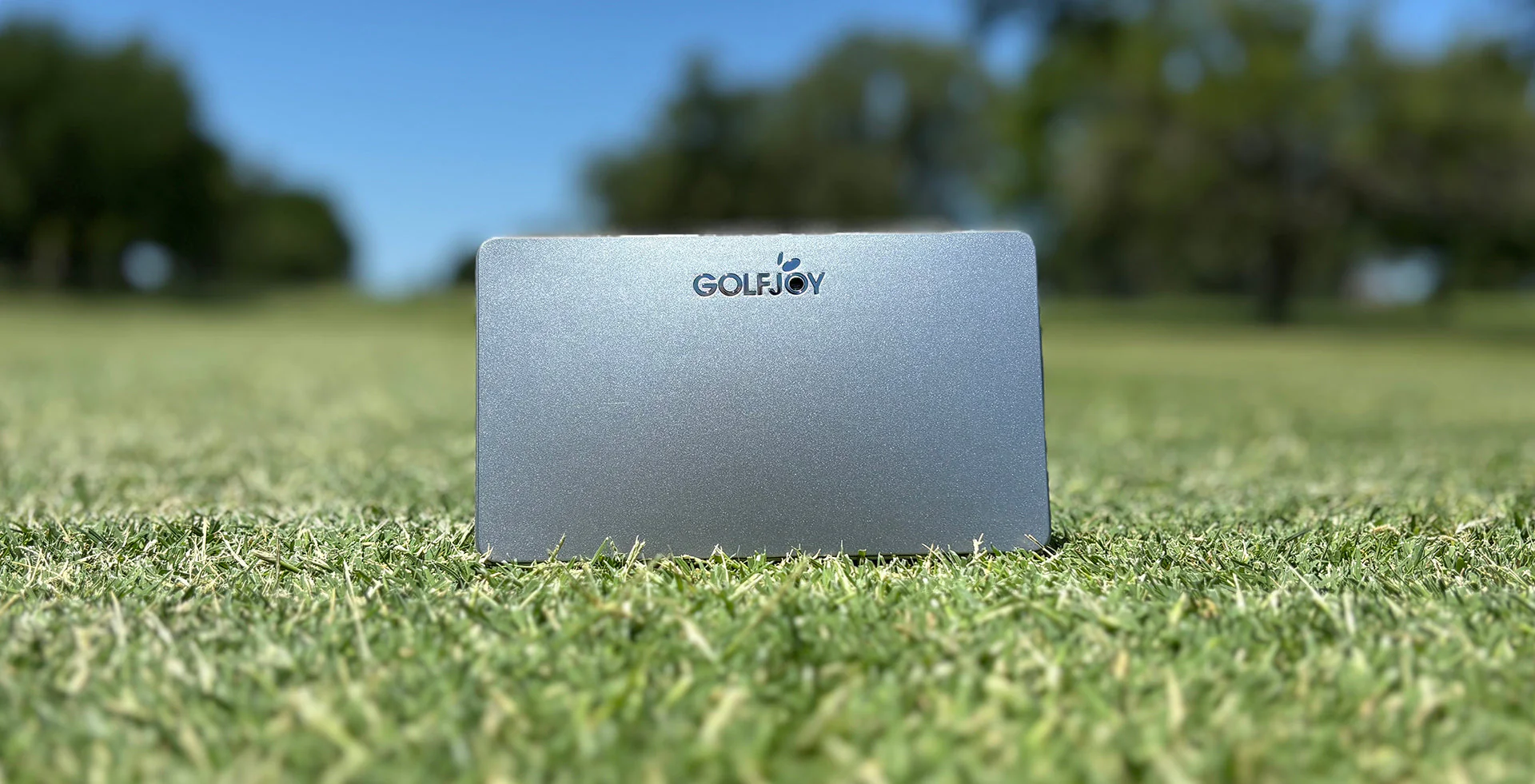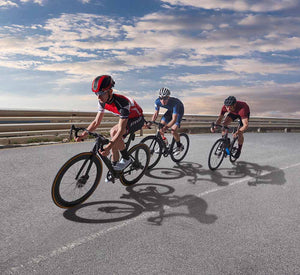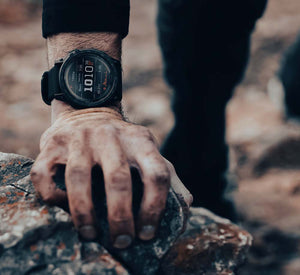
GolfJoy Golf Waver Review: A New Candidate for Best Portable Golf Launch Monitor
The Golf Waver might be the most practical portable launch monitor ever made for the driving range. But how does it hold up to the competition in this price category? As usual, Marc's got detailed answers for you below!
The thing about a lot of golf launch monitors is that it’s often impractical to bring them to the driving range, especially if it’s before you play a round of golf.
There are generally two obstacles to overcome: Ease of setup and portability.
Some golf launch monitors, like the Foresight GC3, can be set up in seconds. But they are too big to then drag around with you out on the course.
Others, like the FlightScope Mevo Plus, are lightweight and can fit easily in your golf bag, but they take several minutes to get aligned correctly and oftentimes aren’t a great pre-round, short-range-session solution.
Then there’s the GolfJoy Golf Waver. This little $599 beauty is super easy to set up and it’s small enough that you can actually fit it in your pants pocket. It only weighs a half a pound! And it features a stout 15-point ball and club data set. For those reasons, I think this might be the perfect product for a specific but very common use case: Outdoor driving range sessions.
Now, before you get too excited, let me just say that, having extensively tested the GolfJoy Golf Waver, it is by no means perfect nor is it going to be a great option for everyone. I’ve identified a few key things that are going to be nonstarters for some golfers.
And remember, the GolfJoy Golf Waver isn’t the only golf launch monitor gunning for the affordable, portable, easy-to-use titles. The Garmin Approach R10, Rapsodo MLM2PRO, and Swing Caddie SC4 obviously come to mind. I’ve used all of those. My job here is to help you learn how they differ so that you can make your best purchasing decision. I’ll call out the good and bad as we go.
If that sounds helpful, please read on for my GolfJoy Golf Waver review.
Table of Contents
Unboxing the GolfJoy Golf Waver Golf Launch Monitor
The GolfJoy Golf Waver outer box is probably nicer than any I’ve seen in the affordable golf launch monitor category. It’s a very rigid, strong, high-quality box that definitely leaves a favorable first impression. I also like the design, including nice graphics down each side of the box listing the included data points. If you were judging a golf launch monitor by its cover, the Golf Waver would be a standout.
Once you open the box, things are very straightforward, which is fine by me. You remove the cover and you see the rather large golf launch monitor carrying case and nothing else. You open the carrying case, and you’ve got the launch monitor, some very short and simple instructions, and a charging cord. That’s it.
As soon as I took the Golf Waver, which comes in either Yellow or Silver, out of its carrying case, I realized how incredibly portable this device would be. It’s so lightweight and sleek. I actually could slide it into my shorts pocket with only the top of it barely sticking out.
And at just a half a pound, it’s crazy how light feeling this product is. Again, it leaves the impression of incredible portability. But it’s also so lightweight and plastic-feeling that it does give off a slightly “cheap” vibe that doesn’t quite align with the high quality of the outer box and the carrying case.
About that carrying case: It’s very nice, but almost too nice. It reminds me of the Garmin Approach R10. Just like with the R10, the case with the Golf Waver is more than twice as large as the device itself. It takes something so sleek and portable and makes it cumbersome once you put it in the case.
I wish a device as portable as the Golf Waver could come in a carrying case that’s as portable as you get with something like the FlightScope Mevo+ or Rapsodo MLM2PRO. It would be nice to have a carrying case that’s as flat and compact as with those two golf launch monitors instead of something as bulky and overkill as with the Golf Waver or Garmin Approach R10.
I’ve knocked products like the Swing Caddie SC4 for not including any kind of carrying case. But, honestly, for the strictly outdoors driving range use case that I see as most realistic for the Golf Waver, I’d probably just ditch the case and slide the device itself into my golf bag. With the SC4, there’s a built-in display that you don’t want to scratch. But I’m not nearly as worried about protecting the cheaper-feeling finish on the Golf Waver. For this product, I’m most interested in maximizing its portability because I think that’s one of its greatest strengths.
Setting Up the GolfJoy Golf Waver
Whether with the carrying case or without it, once you reach your destination, it’s incredibly easy to get going with the Waver.
The process is as simple as downloading the GolfJoy Lite app, pairing the app to the Golf Waver via Bluetooth and then aligning the launch monitor.
Like with the Swing Caddie SC4, the Golf Waver has a built-in kickstand that makes it really easy to place on the ground and get started. But it’s the laser feature that makes alignment so simple. You place the Golf Waver 6.5 feet behind the golf ball, and then you press a button on the side of the launch monitor and it will fire an infrared laser in a straight line directly from where this Doppler radar device is collecting shot information.
I will say that for indoor use the laser alignment system is brilliant. You can have your golf ball perfectly positioned in a matter of seconds. Outdoors, however, depending on lighting, it’s not always easy to see the laser on the ground. I’ve had to use my hand to identify where the laser line is so that I can then find the precise ball placement location. Not a big deal, but it does add a few seconds.
Also, outdoors, I’ve found that the window in which the Golf Waver will accurately read shots is quite small. If I move the ball more than a couple of inches off of the perfect line, the launch monitor won’t consistently pick up the shot. This comes into play as you progress through an outdoor range session on natural grass. After you start taking divots and have to move your ball position, you’ll need to realign your Golf Waver. Luckily, that’s simple to do.
As for indoor setup, the issue is the same as it is with any radar-based golf launch monitor: You need a considerable amount of room depth. The Golf Waver needs to sit 6.5 feet behind the ball, and you need at least 8 feet in front of the ball for the device to have enough space to read the ball flight. That means you need a room that’s at least 14.5 feet long. Not everyone has that kind of space.
But, as I’ll discuss below, I think the Golf Waver is going to be used most often outdoors. Keep reading to find out why.
Golf Waver Golf Launch Monitor Data and Accuracy
The GolfJoy Golf Waver golf launch monitor is quite impressive when it comes to data metrics. While the manufacturer doesn’t spell out which data points are measured by the device as opposed to which are calculated using an algorithm, we can safely assume, based on comparable products, that not all of this data is actually measured. And that does call into question accuracy on a few points, which I’ll get into.
But first, here’s the information the Golf Waver delivers:
- Total distance
- Carry distance
- Ball speed
- Club speed
- Smash factor
- Launch angle
- Backspin
- Apex
- Landing angle
- Launch direction
- Sidespin
- Hangtime
- Attack angle
- Club path
- Deviation
That’s a pretty stout array of information, and it compares favorably to other similarly priced golf launch monitors. With the Swing Caddie SC4, for comparison, you only get:
- Carry distance
- Total distance
- Swing speed
- Ball speed
- Smash factor
- Apex
- Launch angle
- Launch direction
- Spin rate
Even the most impressive of the under-$1,000 golf launch monitors, the Rapsodo MLM2PRO, doesn’t report more data than the GolfJoy Golf Waver.
But where we hit a sticking point is at the same place we do with all of the other under-$1,000 golf launch monitors: Not all of the data is completely believable. In this product class, I still rate the Rapsodo MLM2PRO as the most accurate, just ahead of the Garmin Approach R10.
The Golf Waver, in my experience, was very similar to the Swing Caddie SC4. From wedges through mid-irons, the numbers were spot-on. Distances, swing and ball speeds, smash factor, all very good. Spin rates were typically within 500 RPM of what I saw on Foresight’s software, but that tolerance isn’t quite as good as with something like the R10 or MLM2PRO.
Also, with the shot tracer, big misses were sometimes under-reported and looked too straight on the shot tracer compared to the real-life, outdoor ball flight.
Just like with the SC4, the higher up the bag I went, the more erratic the data tended to get. Sometimes the driver numbers were not believable. I saw distance numbers that were off by as much as 20 yards.
Listen, these affordable golf launch monitors aren’t perfectly accurate in everything that they do, especially when it gets to the longer golf clubs. On the whole, the Golf Waver holds its own on accuracy for this price point, but it’s not leading the class.
GolfJoy Lite App Experience
The Golf Waver, like its larger, photometric GolfJoy launch monitor sibling, the GDS Plus, interfaces with the GolfJoy Lite app. Because there is no built-in display, the app is the only way to access the data.
The GolfJoy Lite app includes a basic driving range, a Combines section for training specific distances and setting offline tolerances, and long drive and closest-to-the-pin skills challenges.
The app is easy to use, and for as simple as it is, I think it’s a lot of fun and offers game-improvement opportunities. But it is limited. One drawback is that the shot tracer replays of your shots are not stored, so you can’t revisit those visuals.
Also, the shot tracer line looks a little flat and 2D compared to other golf launch monitor software. There’s not as much depth so that you don’t get as good of a visual representation of the height of the shots.
The real limitation with the GolfJoy Golf Waver is that it’s just a golf launch monitor. The GolfJoy Lite app doesn’t include any simulator functionality. This is again why I don’t see as much value for indoor setups where simulator golf might be more in the mix. Range sessions outdoors and on the go, on the other hand, are where I see the Golf Waver as a fit.
Golf Waver vs R10 vs MLM2PRO vs SC4
The Rapsodo MLM2PRO is the most accurate.
The Garmin Approach R10 includes the best golf simulator compatibility.
The Swing Caddie SC4 has the best (and only) built-in display.
And the GolfJoy Golf Waver is the most portable.
That’s how I see the under-$1,000 launch monitor race right now.
While the Golf Waver’s data lineup is outstanding, I favor the MLM2PRO for accuracy.
As noted, the golf simulator compatibility is a limitation for the Golf Waver. But that plays directly into the hands of its lightweight portability, ease-of-setup, and obvious overall strengths as an outdoor golf launch monitor.
I’ve got mixed feelings on how the Golf Waver confirms that it’s recorded a shot. On the one hand, the audible beep is nice in that you know for sure it got it without having to look down at your phone or tablet. But when there are other golfers on the range, I find it a little awkward, and I haven’t found a place to mute that sound. With the SC4, I can easily turn off the speaker.
I can see where it might not feel like the market needs another similar $600 golf launch monitor, and I do think the Golf Waver could compete that much better if the price were dropped just a little. But I do think it’s got its place in today’s affordable golf launch monitor lineup.
The Rapsodo MLM2PRO and Garmin Approach R10 both have detachable tripods that add a step to setup. And while the Swing Caddie SC4 has a similar built-in kickstand as the GolfJoy Golf Waver, its built-in screen makes it so that tossing it in your bag for maximum portability is a bit dicey for fear of scratching the screen. It’s a golf launch monitor that needs a carrying case but that doesn’t come with one. With the SC4, that will cost you another $50.
The Golf Waver, of all these products, feels like the on-the-go solution.
Who Should Buy the GolfJoy Golf Waver?
Some name, huh? The GolfJoy Golf Waver golf launch monitor. But, hey, we love golf too.
If you want to get a taste of what some of the modern technology can bring to your game but aren’t all-in on the whole full-blown experience, the Golf Waver is going to give you all of that.
I like that it’s so lightweight. I like that it can legitimately fit in my pocket. I really like the data metric menu, and I think the accuracy is comparable with other products at this price. I’m not wild about the bulky carrying case that, to me, defeats the Golf Waver’s portable selling point. In fact, I haven’t been using my case.
If you’re trying to build a golf simulator studio, this isn’t the product. But that’s not everyone’s objective. For a lot of golfers, less is more, simple is better. If that’s you, here’s the GolfJoy Golf Waver golf launch monitor. Hope you love golf.
About PlayBetter Golf Reviewer Marc Sheforgen
Marc Sheforgen is a golf writer whose passion for the game far exceeds his ability to play it well. Marc covers all things golf, from product reviews and equipment recommendations to event coverage and tournament analysis. When he’s not playing, watching, or writing about golf, he enjoys traveling (often golf-related), youth sports coaching, volunteering, and record collecting.























